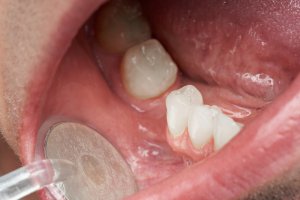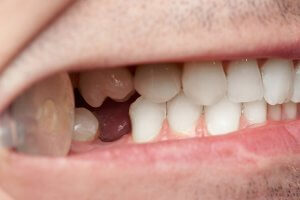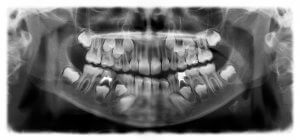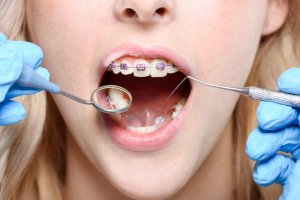Hypodontia, also known as congenitally missing teeth, is a dental condition that means you are born with fewer teeth than normal. Hypodontia in children may affect both baby teeth and adult teeth, although the most common congenitally missing teeth are permanent teeth.
If you or your child have one or more teeth missing from birth, you might be wondering if it’s normal and what you can do about it – especially if you’re left with noticeable gaps between teeth. In this article we’ll give you all the information that you need to know, including:
- The definition of hypodontia
- Causes of naturally missing teeth
- Problems that hypodontia can cause
- Treatments available for congenitally missing adult teeth
We hope this guide answers all your questions and helps you decide on the best treatment if you or your child are affected by hypodontia.
In This Article
What is hypodontia?

Hypodontia is a general term for when someone doesn’t naturally develop all of their teeth. The most common teeth to have missing are wisdom teeth, or third molars. After this, the next most common congenitally missing teeth are the second premolar (that’s the one third from the back, not counting wisdom teeth) and the lateral incisor (the second one from the front).
Read our separate guide which explains how many adult teeth you should have, and when they appear.
How common is it to have congenitally missing teeth? It depends; around 20% of people are born missing one or more wisdom teeth. But putting wisdom teeth aside, studies suggest that between 1.6% and 6.9% of people have at least one of their other teeth missing from birth.
Did you know that it’s also possible to have too many teeth? We have a separate article covering this condition, which is known as hyperdontia or supernumerary teeth.
What about oligodontia?
Hypodontia and oligodontia both relate to the same problem. If there are fewer than six teeth missing, it is called hypodontia, whereas six or more teeth missing is known as oligodontia.

It is rare, but possible, to have all teeth missing. If someone has no teeth at all for genetic reasons, this is called anodontia.
Is microdontia related?
Microdontia is a condition where teeth are smaller than normal. This can happen to all the teeth, or just a few of them. As well as some teeth being smaller, they tend to be pointier too.
There is a link between microdontia and hypodontia. The same teeth are most likely to be affected by both conditions; that is, the second premolar or lateral incisor. The result is often a diastema, or gap between teeth, but this is fairly easy to rectify.
How do I know if I have hypodontia?

Hypodontia is normally diagnosed during a visit to the dentist, often with the help of a dental x-ray. An x-ray makes it possible to see if there are any congenitally missing permanent teeth in children.
Missing teeth might be quite obvious because of the gaps they create. But, when it comes to missing permanent teeth, it’s possible for the primary tooth to stay in place because there is no secondary tooth to push it out. In this case, the hypodontia is less noticeable but it’s likely that the remaining baby tooth will experience problems at some point, such as breakage or dental decay.
Once your dentist has established which teeth are missing, a treatment plan can be put into action. We’ll go through the treatment options further down the page.
Hypodontia causes
It isn’t really clear what the cause of congenitally missing teeth is, although it seems to be strongly linked to genetics. However, it is possible for someone to have hypodontia without any family history of it. Other conditions such as Down Syndrome and ectodermal dysplasia are also linked to hypodontia.
Some scientists suggest that hypodontia is evolutionary. Missing wisdom teeth might have something to do with our jaws changing size as our brains developed, whilst hypodontia in premolars and incisors might have come about because we’re not having to chew through as much raw meat as our ancestors did.
There is also a link between hypodontia and cleft lips and palates; it’s most likely to occur when both the lip and palate are affected by the cleft. When this happens, it is usually the lateral incisor missing (the one next to the front teeth).
Hypodontia in children and adults
Congenitally missing primary teeth occurs in about 1% of children, so it’s pretty rare. With permanent teeth it’s more prevalent, affecting around 5% of people, if you don’t count wisdom teeth.
Congenitally missing teeth more often affects women than men, while men are more likely to have extra teeth or oversized teeth. Scientists don’t seem to have an explanation for this.
Hypodontia treatments
Although a reasonably common dental condition, it can still be necessary to fix the gaps left by hypodontia. There are various health issues that hypodontia can cause, including:
- Issues with speaking and word pronunciation
- Problems properly chewing food
- Psychological issues due to the aesthetics of missing
teeth - Bone loss where the teeth are missing
- Old baby teeth becoming broken or decayed
Treating congenitally missing teeth can include one or more of the following procedures:
- Braces
- Dentures
- Bridges
- Implants
- Bonding
- Veneers
- Extraction (if old baby teeth remain in place)
Hypodontia treatment usually takes place once all of the baby teeth have fallen out (or been extracted) and the adult teeth have come through. In the case of implants, you may have to wait years for the jaw bone to fully develop. However, there are other treatments that can be used in the meantime to fill any gaps.
Next, we’ll go through these treatments in a little more detail, explaining how they can help, what restrictions apply, and what you need to consider before going ahead.
Braces

Braces are likely to be the first part of hypodontia treatment. They are used to move teeth, sometimes to fill in gaps and sometimes to move teeth to create space for other treatments.
Your dentist will fit metal brackets onto your teeth and connect them with wires (and sometimes bands) to move your teeth to the correct position for the next part of your treatment.
Invisalign and other invisible braces can also work for moving the teeth as part of hypodontia treatment. Be aware that this type of brace isn’t available on the NHS and you might not be able to get any follow-on treatment for hypodontia on the NHS if you have already started private treatment. If you are considering invisible braces to treat hypodontia, make sure you understand the full treatment that you need and plan things clearly with your dentist.
Dentures
Dentures, also known as false teeth, are removable appliances which fill the gaps caused by hypodontia and help with speech, chewing food, and appearance. Some people wear dentures their whole lives, but others prefer to use them as a temporary measure whilst they wait to get a more permanent treatment like implants.
There is some extra care that goes into looking after dentures, so if they are being used by a teenager as a stop-gap, make sure they know how to look after them correctly. As a young person grows, they will need regular dental checkups so their dentures can be adjusted to fit their growing mouth and jaw.
Bridges
A bridge is a prosthetic tooth that is held in place by being bonded to the teeth either side of it. There are several different types of bridge, each suitable for different purposes. For more dental bridge information you can read our separate guide.
Bridges are a long-term solution and can last up to fifteen years. They can only be fitted after the jaw has stopped growing, so will probably be part of a long-term treatment plan.
Bridges are one of the treatments covered by the NHS, making them an affordable and long-lasting solution. One downside is that they require some enamel to be removed from the supporting teeth, which is not ideal for a young person with otherwise healthy teeth.
Implants
Congenitally missing teeth can be treated with dental implants, but as with some of the other treatments, they can only be fitted when everything has stopped growing. An implant consists of a small metal screw secured in the jaw bone which supports a crown on top. Implants are a long-lasting option and should look and function like natural teeth.
One issue to be aware of is that implants may not be suitable if you have a missing premolar (which is one of the most common congenitally missing teeth). The bone around the tooth sometimes isn’t dense enough to safely insert the screw. Your dentist will be able to assess your condition and decide whether implants are a possible option for you.
Here, a patient named Jessica talks about her treatment for congenitally missing lateral incisors. Her braces are nearly ready to come off, after which she will complete her treatment with dental implants:
We have a full guide to teeth implant costs that you can read for more information about this treatment option.
Bonding and veneers
If you have microdontia, meaning there is some tooth there but it is smaller than it should be, you may be able to have the rest of the tooth built up with composite or a veneer added as a cover. These options are less invasive than bridges and implants but may not last quite as long, and they require there to be an existing tooth for your dentist to work with.
Is hypodontia treatment available on the NHS?
As with all NHS dental treatments, a dentist has to determine whether there is a clinical need for the treatment. If yes, it will be provided on the NHS. If not, it will need to be done privately.
If hypodontia treatment on the NHS starts before the age of 18, it will normally remain free for everything related to the same issue. Treatment carried out on adults will be charged at the usual NHS rates.
Your dentist will be able to assess the clinical need and the most cost-effective way to treat your dental issues. Usually you can’t combine private and NHS treatment for the same issue, for example by getting braces privately then switching to the NHS for a bridge, but make sure you check with your NHS dentist before going for any private treatment.
Conclusion
Hypodontia is a very common dental problem; so common that scientists think it may be part of our evolution to not need as many teeth!
The treatments for congenitally missing teeth are common and should be simple, although most will have to wait until the patient is fully grown. Your exact treatment plan will depend on how many teeth you are missing and the positions of any gaps. It’s common to need braces to straighten your teeth and prepare your mouth for any other treatments.
LiveScience: Ancient Mutation Explains Missing Wisdom Teeth. Consulted 18th July 2019.
NCBI: Congenitally missing teeth (hypodontia): A review of the literature concerning the etiology, prevalence, risk factors, patterns and treatment. Consulted 18th July 2019.
Hindawi: Hypodontia: An Update on Its Etiology, Classification, and Clinical Management. Consulted 18th July 2019.
Children’s Dental Center: What to Do If Your Child Is Missing a Permanent Tooth. Consulted 18th July 2019.
ScienceDirect: Microdontia. Consulted 18th July 2019.




